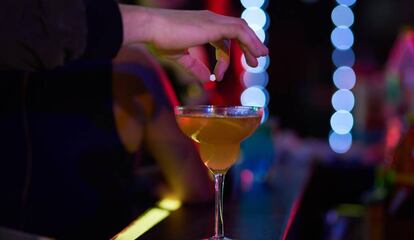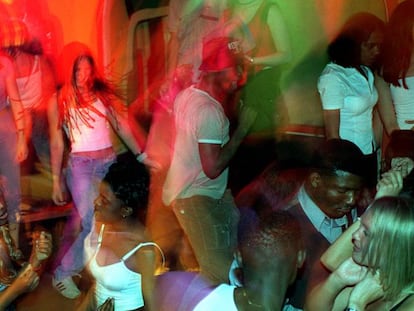The new drugs slipping under the radar in Spain
Experts warn about substances arriving on the market that cannot be detected by traditional testing

Around 35 new psychoactive substances have hit the drug market in Spain. Their existence was detected as far back as 2015 by the Early Warning System, part of the Health Ministry’s National Plan Against Drugs (PNSD), but their immunity to detection by traditional methods makes them hard to control. Consequently, they have become a surreptitious threat, one that was flagged up by the Spanish Observatory for Drugs and Addiction, which stated that 71% of Spaniards had never heard of them.
Now Manuel Isorna Folgar and Antonio Rial Boubeta, two professors from the Universities of Vigo and Santiago who hold PhDs in psychology, are developing the first study on these new drugs to be carried out in the northwestern region of Galicia. The research seeks to measure the extent of their consumption among 14- to 23-year-olds.
The only way forward is prevention and sound policies involving parents and targeting younger age groups Manuel Isorna Folgar, researcher
With the collaboration of their respective universities, both researchers are basing their findings on a survey of 500 students, though it is hoped this number will expand to incorporate 10,000 youngsters with support from the regional government.
“These new drugs are a combination of substances made mainly in China and India by altering their chemical structure to produce similar or more powerful effects than traditional drugs such as cocaine, heroine or hashish,” says Manuel Isorna. “Besides slipping through the net when it comes to controls, many are sold as plant fertilizer, such as mephedrone, or as as bath salts, as cathinone. The label indicates that the product has been packaged in Europe and is not fit for human consumption, but the manufacturers make it clear they accept no responsibility.”
With more than 20 years of experience in drug prevention in Pontevedra province, Isorna explains that another cause for concern is the appearance on the market of synthetic cannabinoids – herbs injected with molecules similar to THC, the main active component in cannabis, but far more potent, triggering panic and psychosis, yet also immune to detection in drug tests.

The study in Galicia also covers the consumption of traditional drugs such as tobacco, alcohol and cannabis to establish whether the manner in which youngsters are taking these drugs has changed. “A lot of youngsters smoke tobacco in e-cigarettes or hookahs because they believe it is less harmful, which is totally false because smoking in this way for an hour is the equivalent of smoking between 10 and 20 cigarettes,” says Isorna.
According to the last PNSD survey, 20.1% of students between the ages of 14 and 18 have smoked electronic cigarettes. With regard to alcohol, there is a growing trend to replace it with a concoction known popularly as “purple drank,” which uses high doses of prescription cough syrup as a base containing both codeine – an opiate – and promethazine – a sedative – and mixed with a lime-flavored soft drink. Because of its opiate content, it is highly addictive.
Then there is the German liqueur Jägermeister, which is mixed with energy and stimulant drinks such as Red Bull. “The kind of consumption popular at botellones [outdoor binge drinking sessions] shows youngsters are trying to cut the price of getting high and also the time it takes by rapidly stimulating the nervous system.”
Joints and strong drinks
According to the experts, current trends in cannabis consumption are also cause for alarm. “It’s possibly what concerns us the most because that segment of the population believes it is innocuous,” says Isorna. “Young consumers should know that the cannabis consumed in Spain before 2000 contained a concentration of THC of around 4%, whereas now the average active ingredient is between 16 and 20%, so smoking a joint nowadays is like smoking four or five joints 18 years ago.”
Some drugs are sold as plant fertilizer or as bath salts
Manuel Isorna, researcher
Experts are also aware that youngsters are trying to get high more quickly and so use increasingly heavy concentrations of THC. For example, some put a drop of so-called butane hash oil on the tip of the joint before smoking it. As it is very hard on the lungs, some prefer to vaporize it in e-cigarettes. “It’s not difficult to find tutorials on how to extract oil from cannabis on the internet,” says Isorna. “Inflammable gas, such as butane, is used, which makes it dangerous.”
“A large part of the way young people enjoy themselves has changed,” he adds. “Nightclubs and traditional pubs are disappearing because they can’t compete with the botellón. However, then you come across the fact that a four-day festival in a village in Albacete [central Spain] attracts more than 200,000 youngsters with a concert, and that it is being sponsored by companies that sell cannabis seeds and alcohol.”
Isorna and his colleague are also aware that internet has made drugs universally accessible at the click of a mouse. “You order them and in a couple of days the mailman brings them to your door without having to go near the darknet. New drugs are appearing so fast that the authorities don’t have time to ban them, while some ‘grow shops’ sell them as incense or air freshener for cars and that’s another threat that is difficult to deal with. The only way is prevention and sound outreach policies involving parents and targeting younger age groups.”
English version by Heather Galloway.









































